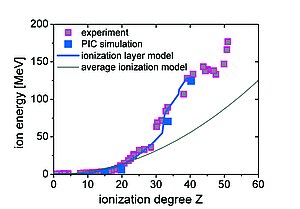All of us are made of stardust - this poetic image contains a lot of (still) unknown, exciting physics that the poet might not really want to tell. Among the top 10 unsolved questions of physics, the question of the origin of the heavy elements - part of the stardust - is also ranked. So far, a deep insight into the interior of the heavy particles and their synthesis can only be gleaned if they collide at extremely high speeds and the resulting fragments of their atomic nuclei are analyzed. Not only nuclear physicists are interested in fast heavy ions but they are also in demand in materials research and medical research.
These ion beams are produced by particle accelerators, which are among the largest and most complex machines in the world. Of course, this also motivates the search for new technical concepts or their improvement. An alternative way to conventional accelerator technology is particle acceleration by laser generated plasma. This requires laser intensities in the so-called relativistic range, where an intense laser pulse accelerates electrons almost to the speed of light. The laser-plasma interaction is determined by relativistic effects of the electron-photon interaction. A single laser pulse generates enormously high, directed field strengths in the range of up to a few megavolts per micrometer in a spatially very limited plasma. In these fields, charged particles can be accelerated to high speeds over a relatively short distance, e.g. also gold ions.
